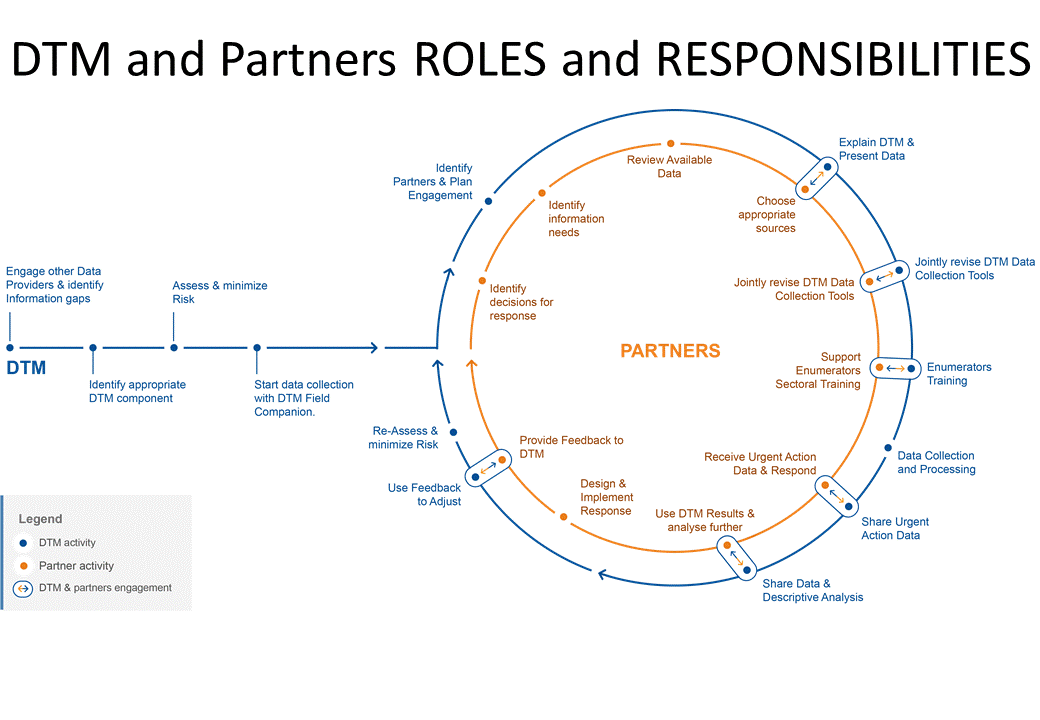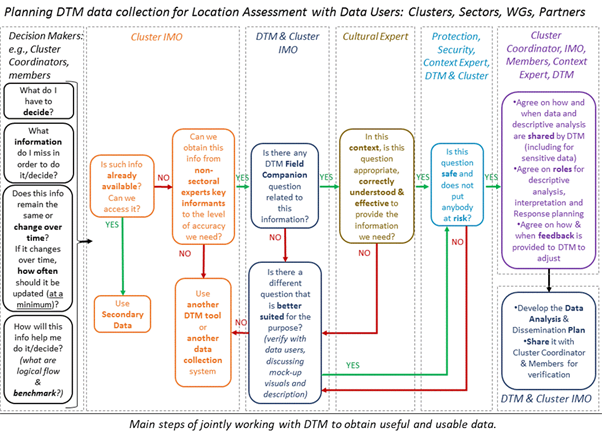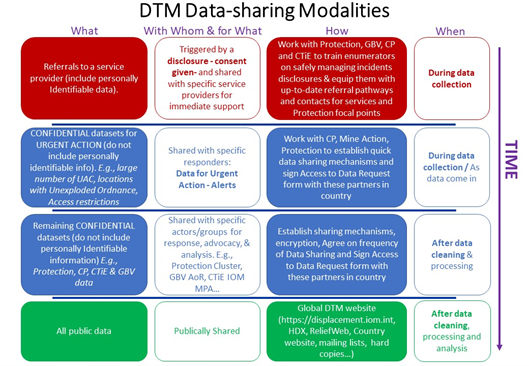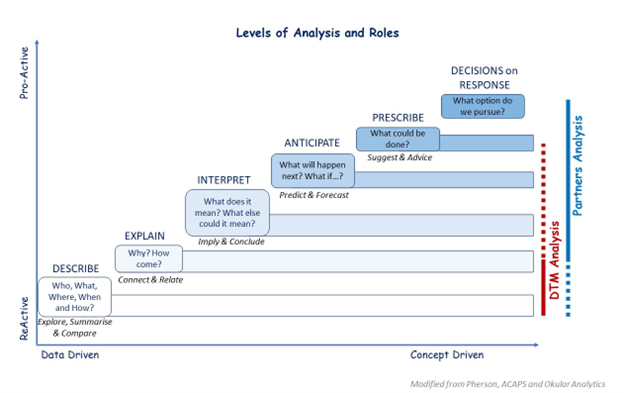- The main steps of the Assessment Process are common to most humanitarian organizations and groups/clusters (see Grand Bargain EDAUUR Tools Ensuring Data and Analysis is Useful and Usable for Response).
- Cooperation is especially needed at specific steps of Assessment Process.

Cooperation must value, respect and make use of different but complementary skillsets:
a) Decision-Makers
b) Subject-Matter Experts
c) Context/Cultural Experts
d) Information Management/Data Experts

DTM and Partners will engage at crucial steps of the assessment process according to their skillsets:
- Identifying information needs
- Identifying the methodology
- Developing data collection tools (Questions and Data Analysis Plan)
- Enumerators training
- Agreeing on Data-Sharing modalities
- Analysis
- Agreeing on Feedback mechanisms

1. DTM and Partners roles when identifying information needs:
- Partners’ Decision-Makers (e.g., Sector/Cluster Coordinator/Members) clearly identify the decisions they have to take, and the information they need but do not have.
- Partners’ Subject-Matter Experts (e.g., Sector/Cluster Coordinator/Members) identify what information is available and accessible, and where gaps are. They also identify the essential building blocks of sectoral information and the most appropriate sources of sectoral information.
- Partners’ Cultural/Context Experts (e.g., local NGOs, Local staff, anthropologists and specialists of the context/culture) help turn abstract information needs into specific local ‘meaning’. They help “translate” information needs into questions that will be correctly understood in that specific context/culture.
- DTM & Partners’ IM Experts listen to and understand identified needs so to translate them into questions.
In order to identify Information that they need for decision making, Partners will have answered the following questions:
- What is it that we have to decide?
- What information do we miss in order to make that decision?
- How often should that information be updated, at a minimum, to be still usable?
- Is that information already available/ accessible?
- How will this information help in the decision-making (What are logical flow & benchmarks)?
- What are the components of the information (e.g., data that can be analysed to obtain the needed information)?
- Are any of these data already available/accessible? (Conduct a Secondary Data Review)
2. Is DTM Location Assessment the appropriate methodology?

- Partners will have to evaluate if DTM Location Assessment is the appropriate source to fill their information gaps, considering method of data collection, level of analysis & measurement, feasibility, resources, time and access of DTM and alternative approaches.
- DTM Locations Assessments mostly use Interviews with Non-Sectoral-Expert Key informants as a method of data collection, at community level. Data collection is carried out at regular time intervals (e.g., one, two or three months) enabling the monitoring of changes over time.
- Partners’ IM experts will be able to explain strengths and weaknesses of the possible data collection methods and help partner select the appropriate data collection method for their information needs.
- If a different method is necessary, partners can discuss alternative DTM tools /components (e.g., ad hoc surveys, registration…), and/or look for a different system (e.g., Cluster own assessment).
3. DTM and Partners Roles when Developing Questions and Data Analysis Plan:

- DTM and Partner IM experts develop draft questions and options for answer with support of sectoral and cultural experts (e.g., Cluster Coordinator and members, local staff and local NGOs).
When phrasing the appropriate questions, the following guiding questions should be considered:
- In this context, using this methodology and this level of measurement, what questions should we ask in order to obtain the data we need?
- In this context, using this methodology and this level of measurement, what options for answers we should give in order to obtain the data we need?
- Is this question safe and does not put anybody at risk? (See Do-No Harm Checklist)
- DTM & Partner IM experts visualize and describe results using fake data (mock-up charts, as in DTM Field Companions).
- Partner decision-makers, sectoral and cultural experts use the description and visualization to verify that drafted questions can indeed provide needed information and link questions to expected use.
- DTM & Partner IM experts make necessary changes to the questions, finalize and share the Data Analysis Plan (DTM Field Companion is formatted as a Data Analysis Plan, and the template can be used to develop the Response DTM Analysis Plan).
4. DTM & Partners Cooperation on Enumerators Training
- Specific partners can provide specialized training for DTM enumerators. This will ensure, for example, that definitions are commonly agreed, and questioning modalities are appropriate (e.g., GBV and Child Protection training provided to DTM by Child Protection AoR colleagues, in: https://displacement.iom.int/dtm-partners-toolkit/trainings)
5. Sharing Data

- DTM shares data and reports mostly through public dissemination (e.g., DTM global website, or country websites) and through mailing lists.
- DTM follows ensures that datasets are shared with metadata and links to methodology, and follows the checklist developed with Global Partners (Checklist on What to include in reports and datasets).
- DTM and Partners should ensure that Partners know where to find DTM data on the Internet, and how to add their address to the mailing list.
- Partners’ colleagues should communicate such information to their replacement when they leave, and ensure the new colleagues are on the mailing list.
- DTM does not share sensitive data publicly. When DTM & Partners identify specific datasets as sensitive in the Data Analysis Plan, they also agree on data - sharing modalities and sign agreements/MoUs to enable sharing.
- DTM & Partners agree on modalities for URGENT ACTION data-sharing. This will ensure that DTM:
- Recognize data needed by partners for immediate action.
- Know how and with whom to share such data in real time, even before data is processed.
6. Analysis

- Analysis is done at various levels, and those levels should be clear to all actors. Each level relies on the preceding ones (See: Roles in Analysis)
- DTM usually conduct explanatory and descriptive analysis of results. In some cases, some explanatory analysis can also be done (e.g., for movements of population).
- However, Explanatory, Interpretative, Prescriptive Analysis and Response Planning are responsibility of the Partners, as per their mandate and skillsets.
- DTM & Partners agree from the planning phase on whether DTM will only share data or also some type of descriptive analysis, depending on time and human resources available. They also agree on the type of descriptive analysis that will be done, through the Data Analysis Plan.
Field experience consistently highlights the effectiveness of targeted presentations of results by DTM. They spark & support accurate interpretation by Partners’ subject-matter experts, context experts and decision-makers. Presentations can be done at clusters, inter-cluster and IMWG meetings, as well as at specific DTM events (DTM & Partners meetings, workshops…) where DTM products, activities and results are shared and feedback is captured. In some cases, a briefing on DTM results & planned activities can be included as a standing agenda point in regular coordination meetings.
For detailed roles in Analysis see: Pocket Guide to the shared approach (pages 20 and 21)
7. Feedback and Adjust
Providing / Obtaining feedback is vital to keep DTM results relevant over time and it is a shared responsibility of DTM and Partners. Feedback can be provided /obtained in various ways, for example:
- DTM and Partner have bilateral discussions or small meetings can provide specific input and enable in-depth understanding of challenges and solutions
- DTM team presents results to Partners and listening to their correlations, interpretation and planning will clarify information needs and greatly contribute to identifying necessary changes to DTM exercise
- Partners share feedback through e-mail or feedback form (contact details for feedback should be shared in reports and presentations)
- Partners fill on-line surveys can help to capture feedback on analytical products
Feedback is then tracked and evaluated by DTM and adjustments are made as appropriate. After acting on feedback, DTM team communicate to Partners how feedback was addressed or reasons for not addressing it. See: See: Providing, Collecting and Acting on Useful feedback
Available Tools
- Roles are detailed in the Pocket Guide to the shared approach (pages 8, and 11-23), in: https://dtm.iom.int/dtm-partners-toolkit/predictable-approach.
- DTM&Partners Cooperation Process, explains steps and roles in cooperation, in: https://dtm.iom.int/dtm-partners-toolkit/steps.
- Roles in Analysis, in: https://dtm.iom.int/dtm-partners-toolkit/analysis.
